End of Austin: West Campus
I’ve been taking photographs of graffiti on and around the University of Texas campus for six years. In that time, I’ve amassed a collection of about 600 photographs, including many return visits to the same, popular locations. I document this public art and anonymous speech for posterity and share a fraction of the results here on this blog.
In the past year or so, there has been a noticeable increase in a certain form of graffiti in West Campus, a historic neighborhood adjacent to the university which is populated predominantly by students and has thus always had a certain, higher-than-average presence of street art, most of it forgettable (tags, illegible scrawlings, and ephemeral, artless posters advertising this or that underground happening). These newer pieces explicitly counter the ongoing gentrification of the neighborhood, referencing property development, displacement, class tensions, and the relatively alienating, cookie-cutter architecture that is quickly edging out older, smaller character properties (and their smaller rents).
The Jacob Fontaine building at 2402 San Gabriel Street, in West Campus (formerly Wheatville), Austin, Texas. Photo courtesy Freedmen’s / Facebook.
WHEATVILLE, TEXAS (Travis County). Wheatville, the first black community associated with Austin after the Civil War, was located at the western edge of Austin on former plantation land. The boundaries of Wheatville corresponded to present 24th Street to the south, 26th Street to the north, Shoal Creek to the west, and Rio Grande Street to the east. James Wheat, a former slave from Arkansas, brought his family to the area and founded the community in 1867. In 1869 he bought a plot of land at what is now 2409 San Gabriel Street and became Wheatville’s first landowner. Wheat raised corn in a site now bounded by Guadalupe, West 24th, and San Gabriel streets. Wheatville residents worked mainly as domestics in white households, merchants in the community, and as semiskilled laborers in the Austin construction industry. A few blacksmiths lived in Wheatville, and some residents farmed and raised livestock. George Franklin, a former slave and a carpenter, purchased land at the site of present-day 2402 San Gabriel in 1869 and constructed a stone building with walls four stones thick. Now known as the Franzetti building, it became the center of the community as subsequent owners used it to house families, grocery stores, various other businesses, and churches. Jacob Fontaine, a prominent Baptist minister, settled at Wheatville in the late 1860s.
From the Handbook of Texas Online.
The biggest changes to West Campus in recent years have come about as a result of the University Neighborhood Overlay (UNO) Plan, a city initiative passed in 2004. The UNO plans were:
“intended to help create a residential district that is close to the campus, consolidating some of the student housing that is presently scattered throughout the city, and thereby reducing transient student traffic to campus from outside, and reducing the transient parking requirements around West Campus.”
The plan seeks to bring University of Texas students closer to campus, as well as create a denser, urban environment in order to provide more space for the growing student population.
From Wikipedia.
Before the 70′s the word “condominium” wasn’t known in Austin. During the 70′s a few condominium complexes were built as “condos” and not “apartments”, the difference being they were better built (especially in sound & thermal insulation) and condos started including washer/dryer connections that most apartments did not. Most of these early condominiums were really more townhomes (typically 2 story with no neighbor above or below) than what most people think of as condominiums. Austin was in a serious growth mode during the 70′s. In the central part of the city, land was just starting to get expensive. It no longer made sense to built single or multi-family properties on these plots of land. Then in 1977, Orange Tree Condominiums was the first condo complex built in the west campus of the University of Texas. These were the first “condos” like most people think of condominiums – larger, many unit, multi-storied (typically 3), more modern styled, with upscaled common facilities like pools, covered parking, etc. It wasn’t long after that Austin started to experience it’s first ‘condo boom’. Every year brought more redevelopment of existing housing being torn down to build condominium communities, not without conflict. These were the growing pains of a city on the move.
From A Short History of Condominiums in Austin by CondoJoe.
Growing pains, indeed. By 2008, the Austin Chronicle was publishing articles such as “Growing Pains Hit West Campus”:
The housing development boom follows a controversial 2001 change in zoning laws allowing for high-density apartment buildings, led in part by Mahone [Mike Mahone, a real estate consultant and mediator for neighborhood developers], who says 35 new projects have gone up over the past four years alone. Mahone believes the increased development is good for the University of Texas, which benefits from easily scheduled classes and higher graduation rates when students can stay closer to campus.
Still, some longtime neighborhood residents don’t appreciate the swift influx of cookie-cutter student housing. “It’s just changed the whole vibe over here,” lamented Donnelly, who rents a 100-year-old home on San Gabriel. “This water thing is a real bummer.” Donnelly says she used to have a view of the UT Tower before the apartments near her home went in. “They disconnected me from this piece of history and then started wrecking my street,” she said. “I hate to see it neglected.”
Four years later, construction in West Campus continues at a brisk pace. The neighborhood has been transformed from a sleepy, quaint, and affordable student enclave into a gentrified and increasingly crowded nest of high-rise luxury condominiums. There are currently multiple, practically sky-scraping developments under construction, the sky itself is crowded with cranes, views to the Tower are a rarity, and many streets are clogged with construction implements with their attendant dust and noise. But West Campus is also the site of a wide—if typically surreptitious—array of graffiti and street art, much of it critical of this “development.”
* * *
So what is graffiti? The regional municipality of Halifax, Nova Scotia, provides a handy definition on their web site: “The difference between art and graffiti is that art is done on property with the permission of the property owner. Art is a creative and productive form of expression. Graffiti is a crime.”* The definition on the web site Art Crimes (at www.graffiti.org) is a little different, defining graffiti as a “term applied to an arrangement of institutionally illicit marks in which there has been an attempt to establish some sort of coherent composition: such marks are made by an individual or individuals (not generally professional artists) upon a wall or other surface that is usually visually accessible to the public.”**
Between these two variant viewpoints is a tension central to the meaning of graffiti that points to the universal function of this form of artistic vandalism; for not all art is vandalism, and not all vandalism is graffiti. Both the detractors and devotees of graffiti insist on the form’s lack of official authorization, its illicitness, its illegality. Graffiti is inherently transgressive.
Finally, beyond these two basic characteristics of graffiti, we can identify one further, crucial attribute: graffiti manifests a presumed universality. Often scrawled alongside or on top of official messages and memorials, graffiti assumes the authority of public writing to publish unapproved, often political or critical messages. Graffiti is necessarily public, and is meant for a wide, general audience. Underlining this universality of audience is the almost invariable anonymity of the author—or, indeed, authors.
Armando Petrucci, in his influential 1980 book Public Lettering, translated into English by Linda Lappin in 1993,*** describes this attempt at and assumption of the democratization of public speech in his exhaustive study of the history of European epigraphy. After discussing medieval and Renaissance epigraphs in the body of this work, he applies some of his conclusions regarding the function of public lettering to the then-fresh and pressingly contemporary social and political upheavals of the 1960s and 70s, particularly as they applied to French and Italian university student uprisings following May 1968, and the flowering (or plague) of graffiti, or as he prefers to call it, mural writing, across European cities. Petrucci, unsurprisingly, sets these outbursts of illicit epigraphic creativity in their proper historical perspective, starting with a quote from the French Renaissance humanist Marc-Antoine Muret:
….who complained that the walls of the university were so covered with “abominable sayings and drawings” that one had the impression of being in a public toilet rather than in an institution of learning. In 1683 (there is nothing new under the sun) the rector of the university of Rome issued an edict threatening to punish anyone “who dares paint or write with charcoal, pencil, chalk, or any other instrument dishonest sayings or drawings, or any letters, signs, characters, verses, mottoes, lines, arms, or notices upon the walls, doors, columns, capitals, windows, or cornices or in any other way deface them, even if he paints or writes nice things.”
* * *
What follows is a collection of photographs taken in West Campus between May 2008 and November 2012.
Click on any thumbnail to enlarge.
- GENTRIFICTION = MURDER
- Austerity [X] Measures
- CLEAN UP THIS ACT
- Old/new
- Buy Less
- MY Hands ARE ClEAN
- DON’T DALLAS MY AUSTIN
- GIVE IT BACK/FUTURE CONDO
- New/old
- Benjamins/ART
- Lindsay Lohan/Failure
- MONSANTO
- Pieta
- ARE WE HAVING FUN YET?
- Failure
- I FEEL LIKE BATMAN
- LOVE THE LIFE YOU LIVE LIVE THE LIVE YOULOVE
- New/old
- Electric socket
- CIVILIZATION IS NOT, AND CAN NEVER BE SUSTAINABLE / KILL CIVILIZATION
- CIVILIZATION IS NOT, ANDCAN NEVER BE SUSTAINABLE / KILL CIVILIZATION
- Failure/skull
- Cat with bomb
- think WAR
- hey! this town sucks!
- this town is awesome
- Failure/Marilyn Monroe
- She Sustains US
- WEST CRAMPED US
- Monopoly
- Failure/Kate Moss
- TRUTH IS A WEAPON
- Downtown condominium, as seen from the intersection of 21st and Nueces in West Campus
- WE ARE THE 99%
- BIG BROTHER IS WATCHING/i am glad you exist
- GAME OVER LOSERS/Ben Bernanke/WE HAVE ALL THE MONEY
- GAME OVER LOSERS/Ben Bernanke/WE HAVE ALL THE MONEY!
- WAGE PEACE
- Crane
- Daniel Johnston mural graffitied
- WAR ON TERROR?/WAR IS TERROR!
- GOOGLE OCCUPY AUSTIN / OCT. 6th
- End The FED!
- Monsanto/polar bear
- New streetscape, Rio Grande Street
- STOP WARS
- MASK UP/OCCUPY
- Long live the Queen!
- CAN MAKE DUMPSTERS TALK
- Old and new
- Statue of Liberty with gun/C.R.E.A.M.
- Crane
- EXCESS
- HOOK EM HORNS! Commissioned mural in the style of graffiti, University Co-op parking garage
- Commissioned mural in the style of graffiti, University Co-op parking garage / actual graffiti
- me heart’s beating a thousand feelings the energy exceeds my walls my ceiling my aura a yellow sunshine bleeding into a rainbow of colors working on reaching a pot of gold so endlessly streaming like a river rolling in circles repeating only hope and the future’s fleeting since i’ve been told the time is now
- WAR IS THEATRE/WITH LIVE AMMO / Make Walls Talk…/WE SPEAK
- SAY SOMeTHiNG!/TSA
- Where do you think you’re going?
- Fuck the police!/rat pack
- CLASS WAR!!
- LIES
- Austerity [X] measures
- Old/new
- IN AUSTIN AS IT IS IN HEAVEN.
Freedmen’s under construction – a new bar in the long-vacant Jacob Fontaine building. Photo courtesy Freedmen’s / Facebook.
*Graffiti.org. Art Crimes. Graffiti Definition: The Dictionary of Art. Retrieved November 29, 2012 from http://www.graffiti.org/faq/graf.def.html
**Halifax Regional Municipality. What Is Graffiti? Graffiti or Art? Retrieved November 29, 2012 from http://www.halifax.ca/corporate/graffiti/whatisgraffiti.html
***Petrucci, A. (1993). Public lettering: script, power, and culture. Chicago & London: The University of Chicago Press.
This piece was developed from an essay about graffiti on campus monuments titled “Conspicuous Blankness: Graffiti Writing and The University of Texas at Austin as Text,” written for Professor Michael Winship’s Spring 2011 course, Introduction to Bibliography and Textual Studies. Special thanks to Professor Winship for encouraging further documentation and publication of these photographs.
Susan Floyd is a UT alumna (English, ’01) and staff member (Department of French and Italian, Center for European Studies). On the side, she’s also a food blogger (stellacooks.com), aspiring archivist, amateur medievalist, and street art photographer. She is also an alumna of the University of York (UK, English, ’03), and a lifelong Anglophile who previously lived and worked in the UK for four years. She lives in downtown Austin with her partner Eric and their two cats. Other interests include Texana, calligraphy, Liverpool FC, whiskey, International Klein Blue, and The Real Housewives of New Jersey. Her personal blog is at stellatex.wordpress.com.



![Austerity [X] Measures](https://conspicuousblankness.files.wordpress.com/2012/11/8202705491_71ee13d828_b1.jpg?w=112&h=150)








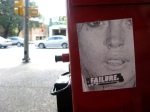





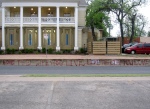















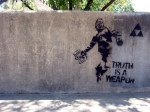



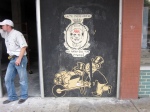
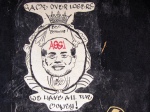









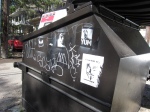















![Austerity [X] measures](https://conspicuousblankness.files.wordpress.com/2012/11/8204671692_de08e5f9f5_b1.jpg?w=150&h=150)




Pingback: This Week’s Eats: 04/19/13 | STELLA COOKS
Pingback: My Austin graffiti photo essay is featured in the new End of Austin | Texarchivist